Treating Fractures in the Field
Lesson 5: Fractures of the Upper Extremities
5-6
5-6. IMMOBILIZE A FRACTURED FOREARM WITH AN IMPROVISED SPLINT
A fractured forearm can be splinted using one or two rigid objects. Figure 5-7 shows an improvised splint using a single board as the rigid object.
a. Gather one or two rigid objects, securing materials, and padding. The rigid object(s) should extend from the elbow to beyond the fingers.
b. Pad the rigid object(s).
c. Check the casualty's pulse below the fracture site. If no pulse is found, evacuate the casualty as soon as possible after the splint is applied.
Figure 5-7. Improvised splint applied to a fractured forearm.
d. Place the padded rigid object under the casualty's injured forearm so the splint extends from the elbow past the fingers. If two rigid objects are used, place the second padded rigid object on top of the forearm.
e. Place a rolled cravat or similar material in the palm of the casualty's cupped hand (see figure 5-2) and turn the hand so it will be in a natural position (palm toward casualty's body).
f. Secure the rigid object(s) with at least three cravats or other securing material.
(1) Apply the first cravat between the fracture site and the elbow.
(2) Apply the second cravat between the fracture site and the wrist.
(3) Apply the third cravat in an "X" fashion over the hand. Leave the fingernails exposed so a blanch test (pressing on nails, then releasing to see how fast color returns to the nail beds) can be performed.
(4) Tie the tails of the cravats in a non-slip knot on the outer part of the rigid object and tuck in the tails.
(5) Check the casualty's pulse after each cravat is applied. If the pulse can no longer be detected, loosen the cravat and apply it again. If this does not restore circulation, evacuate the casualty as soon as possible.
g. Apply a sling and a swathe to further immobilize the injured arm.


